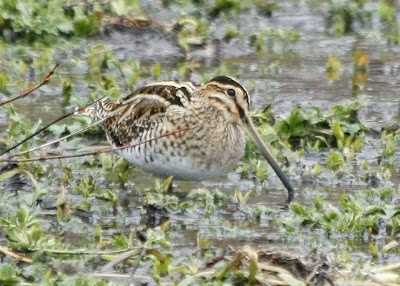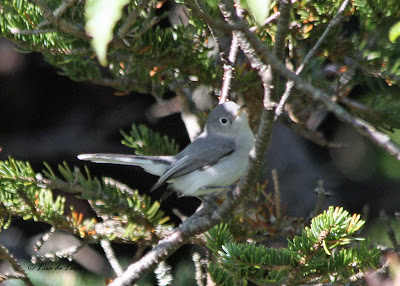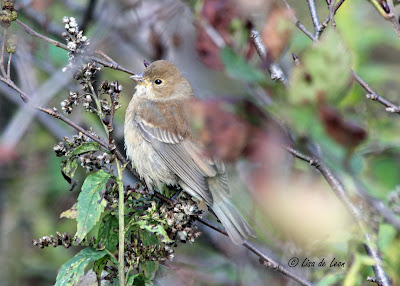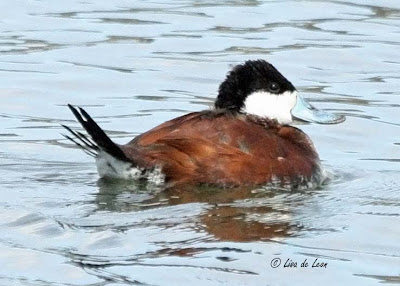Among my favorites was this great American Avocet. All of the birds that I have included today have individual posts written about them throughout the year. If you would like to see more info about the location or the experience, please run a search for the bird in the above search box.
These birds are not listed in any particular order of appearance but rather the convenient alphabetical order under which I file my pictures. This Anna's Hummingbird created quite a stir in the early months of last year. Unfortunately, the weather proved to be too much for it. This was actually a rare year for hummingbirds on the Avalon. In addition to this great little bird, Rufous and Ruby-throated Hummingbirds also appeared. I missed seeing the two reported Ruby-throated. Oh well, that is something to aspire for in the new year.This Blue Grosbeak was a life bird for me. In fact I was able to see three of these this year. The birds that I have included today are considered rare or extra rare to Newfoundland. It does seem though that some of these rare birds show up in numbers when they do come.
Most all of these rare birds were "life" birds for me, including this Brant that turned up in Harbour Grace in the Fall. It is birds like this that prompt birds to fuel their tanks, re-charge their batteries and set out to locate and share in the excitement of yet another unexpected visitor.
The Caspian Tern was a first for me as well. It turned out that several of these birds appeared around the Avalon this year.
This rare Common Chaffinch was a big surprise. Lucky for us birders it stayed in the area where it was first reported by a back yard birder.
The Common Moorhen is a strange looking bird. It most resembles the American Coot that turn up on the Avalon most every year.
The Great Egret is the antithesis of the Common Moorhen with its grace and beauty. While Great Egrets have no reason to be here this year at least four showed up in areas that were easily viewed by many. Even non-birders can't pass this bird up without stopping to enjoy the moment.
The Fork-tailed Flycatcher was another show-stopper during the year. This very rare bird turned up in Renews where the population of Renews must have doubled with all of the visiting birders.
This Blue-gray Gnatcatcher provided one of my most rewarding birding experiences this year. Some birds are easy to refind as they are often right where they were reported. This Blue-gray Gnatcatcher was not. It took hours of looking and working to find it. At last after several hours we were rewarded with a short two minute show. This bird was located on the East Coast Trail near Cape Spear.
The Indigo Bunting was a particularly nice find. There had been several reported and I checked the areas but could not turn it up. Then one day quite unexpectedly two appeared before me. The irony around this bird find was that when I had it, I didn't know what it was. It was back to the books for me.
The Little Blue Heron is a common sight in Arkansas but not here. This one found by Dave Hawkins rallied the troups again. A new path was easily beaten down leading to the edge of a small marshy area where this bird stayed for at least a week. (Note: Dave also found the American Avocet above. What a thrill it must have been to find these two great birds.)
During 2011 we had two Northern Mockingbirds. This one stayed in the same location for quite some time last winter. The latest one I found on a day in late November has not been seen again. It has to be around somewhere. I am still keeping an eye out for it.
This little Northern Parula found at La Manche was an exexpected thrill. I was watching a number of small birds that had gathered on this road early one morning when out it came. I certainly was not expecting this one. This bird is classified as an Uncommon bird in our area but to me, it was rare!
This Red-bellied Woodpecker is still here. It was located by Anne Hughes around mid-
December and has been putting on quite a show. Extra suet feeders have been put up in the area and he still seems to be doing very well. This is a first record of this bird in St. John's.
Over the year we have had three Ruddy Ducks in the St. John's area. These two were found at Forest Pond by Catherine Barrett. The pair was a great complement to the male that is pictured below that spent quite a bit of time at Quidi Vidi Lake last spring.
Then, there was the Ruff. Catherine Barrett found this bird at Fourth Pond late one afternoon. All the birders that got in the car right away and set out were able to see the bird. Those who decided to wait until the next day were disappointed. This bird didn't stay around very long. It could have easily been missed.
There is something really special about Vireos. This was the first year that I was able to see several species and to observe their behaviour. Among them was this Warbling Vireo that is among the rare visitors. This bird was located on Cape Spear Road. Also found on this road by Anne Hughes was a Black-throated Blue Warbler. While I was able to get a fair look at the bird from inside my car, when I got out to take a picture it vanished into the woods.
Back to Renews...this Western Kingbird turned up on the outskirts of Renews. It stayed in the same area for about three weeks. Since then I have not heard any further reports. Even though it looks a little scruffy from its travels it is still a beautiful bird.
I had to walk quite a distance to see this Northern Wheatear but it was worth it. When I reached the cliff where it was first sighted, I was lucky to encounter Mike Palmeter who already had located the bird. With his help I was able to see it and watch its flighty behaviour for about three or four minutes before it took off.
Often movies will reference a Yellow-bellied Sapsucker. I never expected to see one but a short drive with Dave Brown (who is just clueing up a Big Year for Newfoundland) led us straight to this bird. Its colors were stunning.
One of my best finds this year was the Yellow-billed Cuckoo. I was lucky once again to find what I think was the same bird in two different locations. This is a bird that I had really wanted to see so it made the sighting very special.
This Yellow-crowned Night Heron turned up at Quidi Vidi Lake on my birthday. What a great birthday surprise! It was one of those one-day wonders as well. The weather was pretty miserable on that day with quite a lot of rain so maybe he just decided he better move on.
 It was my good fortune to come across this Solitary Sandpiper at Forest Pond. When you are new at birding, it is easy enough to tell if a bird is not common but it is not always easy to know what it is. With pictures and field guides I was able to make an ID of this bird. I am indeed making progress.
It was my good fortune to come across this Solitary Sandpiper at Forest Pond. When you are new at birding, it is easy enough to tell if a bird is not common but it is not always easy to know what it is. With pictures and field guides I was able to make an ID of this bird. I am indeed making progress. Snipe also caused quite a stir this year. Two Common Snipe appeared and with the photos and knowledge of Dave Brown they were confirmed Commons. For more info about this you can link to Dave Brown's site through a link on the right of this page. Also documented this year was a Jack Snipe found by Paul Linegar. I missed that one.
Snipe also caused quite a stir this year. Two Common Snipe appeared and with the photos and knowledge of Dave Brown they were confirmed Commons. For more info about this you can link to Dave Brown's site through a link on the right of this page. Also documented this year was a Jack Snipe found by Paul Linegar. I missed that one.The rarest of them all this year is the White-breasted Nuthatch that turned up in St. Lawrence. That is a first record for that bird but unfortunately, I did not get out to see it. Time and distance kept me from making the day-long trip for that one.
Currently, there are two rare and uncommon warblers regularly visiting feeders in St. John's now. These are the rare Pine Warbler showing up at the suet feeder at the home of Anne Hughes and the uncommon Cape May Warbler visiting the feeder of Gene and Karen Herzberg. The appearance of any warbler at this time is the year is rare. By the way it you want to see some really good pictures of these rare birds visit Gene's Flicker page. The link can be found on the right hand side of this page.
Update January 1, 2012: As reported by Bruce Mactavish in The Telegram (December 31, 2011) "Winging it" column: There was a total of 292 species recorded in Newfoundland and Labrador during 2011. This is 16 more than 2010. Among these there with 19 species of gulls, 38 species of shorebirds, three species of hummingbirds and 30 species of warblers. Amazing!






































No comments:
Post a Comment